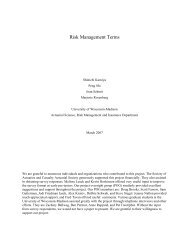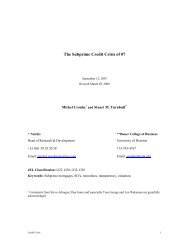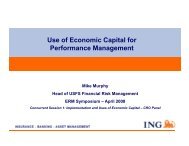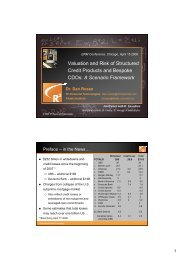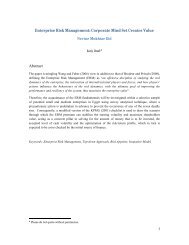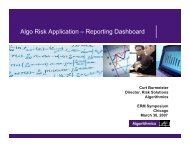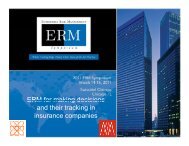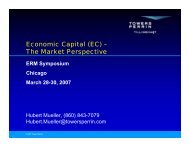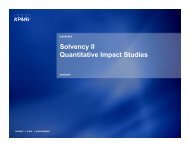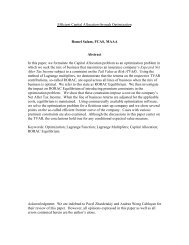Bayesian Risk Aggregation: Correlation ... - ERM Symposium
Bayesian Risk Aggregation: Correlation ... - ERM Symposium
Bayesian Risk Aggregation: Correlation ... - ERM Symposium
Create successful ePaper yourself
Turn your PDF publications into a flip-book with our unique Google optimized e-Paper software.
the level of individual instruments or positions without the need for creating artificial risk<br />
silos. Such sophisticated approaches are particularly important for market and credit risk,<br />
which are highly related and inextricably linked with each other, see e.g. the Research<br />
Task Force of the Basel Committee on Banking Supervision [2] and Hartmann, Pritsker,<br />
and Schuermann [14] for more about the interaction of market and credit risk.<br />
While financial institutions and supervisors are seeking for flexible bottom-up methods<br />
for the aggregation of market and credit risk, conceptual difficulties remain with respect<br />
to other risk types such as operational risk and business risk. As a matter of fact, banks<br />
are currently still favoring simpler top-down methods when computing their aggregated<br />
EC as pointed out in IFRI/CRO Forum [15]. According to this survey the most popular<br />
method in practice is the aggregation-by-risk-type approach where stand-alone risk figures<br />
of different risk types are combined in some way to obtain the desired aggregated EC. In<br />
a similar, more recent survey of the Basel Committee [3] it is reported that “there is no<br />
established set of best practices concerning risk aggregation in the industry.” From all this,<br />
it can be expected that for quite a long time hybrid approaches that at least partially rely<br />
on an inter-risk-correlation matrix, will heavily influence market practices.<br />
The simplest form of risk aggregation expresses the dependence between different risk<br />
types by an inter-risk-correlation matrix R, and its estimation and calibration is a core<br />
problem for the calculation of total EC in practice. A standard approach is to model the<br />
dependence structure between risk types by a distributional copula, see e.g. the references<br />
in Böcker [5]. Estimates for inter-risk-correlations differ significantly within the industry.<br />
The IFRI/CRO Forum [15] points out that“correlation estimates used vary widely, to<br />
an extent that is unlikely to be solely attributable to differences in business mix.” This<br />
obviously shows that the estimation of inter-risk correlations is afflicted with high uncer-<br />
tainties. One reason for this is that very often reliable data are scarce and do not cover<br />
long historical time periods. Therefore, inter-risk correlations are approximated by the co-<br />
movement of asset price indices or similar proxies of which, it is hoped, are representative<br />
for these risk types. As a consequence thereof, a reliable and robust statistical estimate of<br />
the inter-risk-correlation matrix is often not possible and it is necessary to draw on expert<br />
opinions. This has recently also been acknowledged by the Committee of European Bank-<br />
ing Supervisors in their recent consultation paper [8], where they explicitly distinguish<br />
statistical techniques versus expert judgements.<br />
Our work makes two novel contributions for estimating aggregated EC within an<br />
aggregation-by-risk-type framework. First, we explicitly address the existence of param-<br />
eter uncertainty associated with the inter-risk-correlation matrix. Second, we present a<br />
sophisticated method for assessing inter-risk correlations (more precisely, the Gaussian<br />
copula parameters) by means of expert judgement. To illustrate our approach, we calcu-<br />
3



